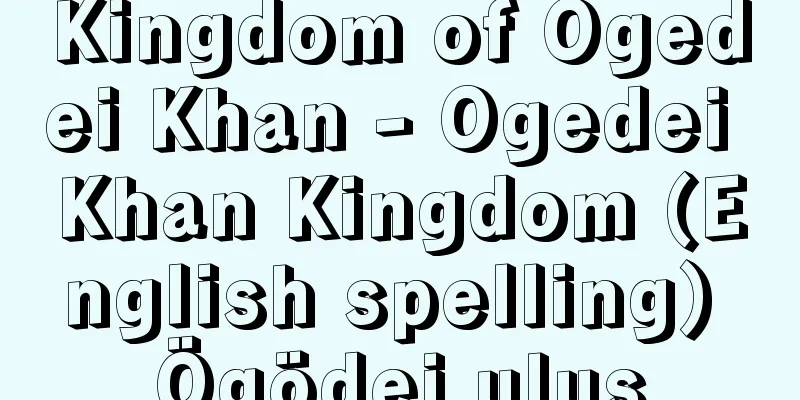Ruiju Myogisho - Ruiju Myogisho

|
An ancient Chinese character dictionary. It classifies Chinese characters according to 120 radicals such as "人" (people) and "彳" (bishop), and notes their pronunciation, meaning, Japanese reading, etc. There are two versions, the first edition and the expanded edition, and because it has the titles "Buddha," "Law," and "Sang," it is also known by other names such as "Sanbo Rui Jishu." [Yutaka Tsukishima] First SelectionIt is a work of six volumes, of which only one remains. It is housed in the Archives and Mausolea Department of the Imperial Household Agency. It was copied in the late Heian period and completed around the end of the 11th century. The author may have been a Hosso sect priest. It faithfully quotes from many previous documents, such as old dictionaries, Buddhist texts, and ancient reading annotations, making it an important resource for the study of Japanese language history. [Yutaka Tsukishima] Expanded editionThere are versions at Kanchi-in (12 volumes, the only complete edition, held at Tenri Library, a copy from the mid-Kamakura period), Kozan-ji (two volumes in existence: Bukkō-jō and Bukkū-chū, held at Tenri Library, a copy from the mid-Kamakura period), Renjō-in (no copies of Bukkō-jō-chū, Hō-jō-chū and Sō-jō-chū-chū-ge), and Sainen-ji (Bukkō-jō). It was recompiled by a Shingon Buddhist monk around the end of the 12th century, and based on the original edition, the names of sources and Chinese annotations were deleted, Manyōgana was changed to katakana, and Japanese readings were added. The numerous annotations and the 40,000 Japanese readings are essential for the study of ancient languages. [Yutaka Tsukishima] "Ruijū Myōgi Shō 1 and 2, edited by Masamune Atsuo and annotated by Nakata Norio (1975, Kazama Shobo)" ▽ "Ruijū Myōgi Shō, annotated by Tsukishima Yutaka (1976, Benseisha)" At the end of the Heian period, it adopted the format of "Gyokuhen", indicated the meaning of each kanji character in katakana, and included many compound words of two or more characters, making it practical. "Sō Jo" Reproduction held at the National Diet Library "Ruijū Myōgishō" Source: Shogakukan Encyclopedia Nipponica About Encyclopedia Nipponica Information | Legend |
|
古代の漢字字書。「人」「彳」等120の部首により漢字を分類し、発音、字義、和訓等を注記したもの。初撰(しょせん)本、増補本の別があり、「仏」「法」「僧」の篇名(へんめい)をもつので『三宝類字集』等の別名がある。 [築島 裕] 初撰本六帖(じょう)か。うち一帖のみ存。宮内庁書陵部蔵。平安末期写。11世紀末ごろ成立。著者は法相(ほっそう)宗の僧か。古辞書、仏書、古訓点など多数の先行文献を忠実に引用し、国語史学上重要な資料である。 [築島 裕] 増補本観智院(かんちいん)本(十二帖、唯一の完本、天理図書館蔵、鎌倉中期写)、高山寺本(仏上・仏中の二巻存、天理図書館蔵、鎌倉中期写)、蓮成院(れんじょういん)本(仏上中・法上中・僧上中下の零本)、西念(さいねん)寺本(仏上)等がある。12世紀末ごろ真言宗僧により改編されたもので、初撰本に基づき、出典名、漢文注を削り、万葉仮名を片仮名に改め、和訓を増補したりした。多数の字音注や4万に上る和訓は古語研究上必須(ひっす)のものである。 [築島 裕] 『正宗敦夫校訂、中田祝夫解説『類聚名義抄1・2』(1975・風間書房)』▽『築島裕解説『類聚名義抄』(1976・勉誠社)』 平安時代末、『玉篇』の体裁をとり、各漢字の意味を片仮名で示し、2字以上の熟語も多く集めて実用的になった。「僧 上」 複製国立国会図書館所蔵"> 『類聚名義抄』 出典 小学館 日本大百科全書(ニッポニカ)日本大百科全書(ニッポニカ)について 情報 | 凡例 |
>>: Ruijufusensho - Ruijufusensho
Recommend
Angola Colobus - Angola Colobus
...Head and body length is about 70 cm, tail leng...
Horaku - Kogaku
〘Noun〙 Music of the ancient northern Hu country of...
Alimony - Arimony
…It was not included in the old Civil Code provis...
Sanage Kiln - Sanageyo
A famous kiln representing the Heian period. Exca...
Super Express of Dawn - Akatsuki no Chotokkyuu
…His 100m record of 10.3 seconds, which he set in...
Olduvai
…the oldest Paleolithic culture in the world, loc...
Shambhala
...A legend about Shambhala (Shambala), a Buddhis...
Erotic literature
It is difficult to give a strict definition, but ...
Shiobara [town] - Shiobara
An old town in Nasu County, northern Tochigi Prefe...
Catalan - Catalan
It is a language that belongs to the Italic branch...
School phobia - gakkou kyoufushou
...A child refuses to go to school due to anxiety...
Koyo Ozaki
Novelist. Real name Tokutaro. "Momiji" ...
Sadler's Wells Ballet
…Britain's leading ballet company. This name ...
Turquino, Pico (English spelling) TurquinoPico
… [Nature] About 60% of the country's land ar...
Kyoenhitsu - A writing brush
…Each of them had a brush holder. Prior to this, ...









